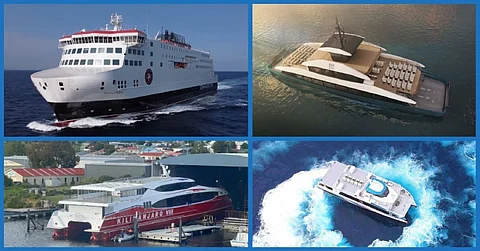

A new high-speed ferry has begun operating in the Taiwan Strait while sea trials are ongoing for a Ro-Pax vessel to serve the Isle of Man. Construction is nearly completed on a fast catamaran for a Tanzanian customer. Lastly, a Portuguese builder starts work on a battery-powered vessel to be fitted with an autonomous charging solution.
Taiwanese operator welcomes new catamaran ferry to fleet
Glow Marine of Singapore has delivered a new aluminium catamaran ferry to an undisclosed operator in Taiwan.
Pegasus 3 was designed by Netherlands-based CoCo Yachts. It has an LOA of 30.95 metres, a beam of 10 metres, a draught of 1.45 metres, and capacity for 196 passengers and two wheelchairs.
Two MTU 16V4000M65L 2,560kW engines drive Kongsberg S71-4 waterjets via ZF gearboxes to propel the ferry to speeds of just over 38 knots.
Pegasus 3 has since begun operating between Kaohsiung and Xiaoliuqiu island in the Taiwan Strait.
Isle of Man Steam Packet Company's newest ferry starts sea trials
South Korean shipbuilder Hyundai Mipo Dockyard has begun conducting sea trials of a new Ro-Pax ferry ordered by the Isle of Man Steam Packet Company (IOMSP).
Manxman underwent initial trials to test a number of important systems including propulsion equipment, controls, mooring, navigation, radio, and anchors. Additional trials to test speed, stabilisers, and sound and vibration levels will be carried out closer to the vessel's scheduled date of completion.
The ferry will be the third IOMSP vessel to be named Manxman.
Australian builder launches ferry for Tanzanian owner
Richardson Devine Marine (RDM) of Hobart, Australia recently launched a new catamaran ferry slated for Azam Marine of Tanzania.
The 53-metre-long Kilimanjaro VIII will then undergo completion works and sea trials. Delivery to its owners is scheduled for early 2023.
The newer ferry will feature a parallel boarding system, whereby five ramps on either side of the vessel will be able to load passengers and cargo in segregated flows. VIP and business class passengers will board into a discreet stair tower directly to the upper deck cabin, whilst economy passengers will load separately aft and amidships.
A fifth ramp will be dedicated to luggage trolley movements.
The designer said the boarding system will ensure passenger classes and luggage trolleys remain separated, reducing turnaround time and improving safety, whilst providing exclusivity for premium passengers.
The catamaran will seat 340 passengers in its main deck economy cabin whilst the mid-deck cabin will accommodate 36 VIP passengers and 12 business class passengers in full lie-flat seats. The remainder of the mid-deck will accommodate 266 economy passengers.
The luggage room can house up to 10 tonnes of luggage and cargo.
The ferry, which also has IMO HSC code-compliant stability, is powered by two Cummins QSK95-M main engines.
Construction underway on Portuguese electric ferry
Portuguese shipyard Navaltagus has begun construction on the first electrical vehicle and passenger ferry to be built in Portugal.
The vessel will have a length of 37 metres and capacity for 260 passengers and 19 vehicles. It is scheduled to enter service in the summer of 2023, plying the route between Forte da Barra in Ilhavo and Sao Jacinto.
The ferry will also be capable of shore power charging thanks to a Zinus autonomous connection that will enable the batteries to be charged while the vessel is at berth.
